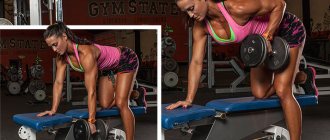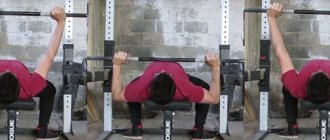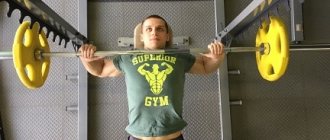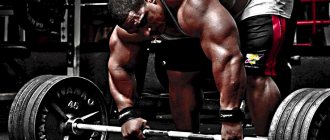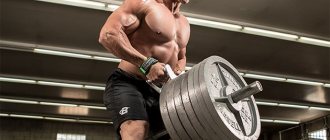Men's breasts can also be beautiful. For men, this beauty lies in the large volume and definition of muscles. It is not difficult to achieve this, you just need to train hard and correctly. One of the most effective and popular exercises for pumping up the chest is the bench press. When performed correctly and selected weights, it allows you to increase the volume of the pectoral muscles in just a few sessions. In addition, the bench press has an effect on the strengthening and growth of the muscles of the shoulder girdle and arms. But the main thing in the bench press is to perform the exercise correctly, observing the technique.
The bench press is performed using so-called “free weights”. These are various strength training equipment with barbells, dumbbells and even kettlebells.
Types of bench press and what they affect.
There are quite a lot of types of bench presses; in sports there is a whole discipline in powerlifting - powerlifting. But we will look at the types of bench press for home use.
The grip width of the barbell can be medium, wide or narrow, depending on which muscle group the exercise is aimed at.
Classic grip.
In it, the palms are located at a distance slightly wider than the shoulders, usually 50-60 cm. The load on all muscle groups working in the exercise is maximally balanced, which allows them to be pumped evenly. To target a specific muscle, you need to use a wide or narrow grip.
Wide grip.
The distance between the palms is greater than the classic one, which puts a greater load on the pectoral muscles. Attention! With a wide grip, you often want to “beat” it away from the chest when moving the barbell down. This cannot be done; the likelihood of injury increases and breathing becomes difficult, which increases the load on the cardiovascular system, which can also lead to a deterioration in overall well-being and the development of diseases of this nature.
Narrow grip.
Here the distance between the palms is minimal, but it is necessary to select the correct weight to avoid injury to the hand. This grip for the bench press is aimed more at pumping the triceps.
Types of dumbbell presses
Dumbbell bench press on a horizontal bench . This exercise pumps the entire chest (top, middle, bottom). But the main load is taken by the middle of the chest.
Incline dumbbell press . This approach thickens and strengthens the upper chest and tightens the inner edge of the pectoralis major muscle.
Seated dumbbell press . The anterior and middle deltas are loaded. Variation of press in front of you from behind your head.
Accordingly, for all types of bench presses, you need to select the appropriate weight and perform it correctly, observing the technical side.
That's all for today until we meet again. If you want to add, write in the comments. Best regards, Sergei. Involve your friends, acquaintances and relatives in a healthy lifestyle and proper nutrition. Become a beacon for them. After all, no amount of money can buy health. Did you like the article? Share with your friends
Forward or reverse grip?
A reverse grip, unlike a direct grip, is performed with the palms turned towards the person performing the exercise. This reduces the load on the hands and uses the biceps as a stabilizer, thereby allowing you to carry out the load on it. When using a reverse grip, exercises must be performed with a partner, since lifting the barbell alone cannot be done, as well as several short approaches and light weights to prevent injury to the elbow joint. Therefore, it is necessary to perform exercises with a reverse grip carefully and always with safety net.
Why is the bench press a basic exercise?
A basic exercise is considered to be one that affects almost all muscle groups of our body. For example, squats with a barbell load not only the legs, but also the back, shoulders and a little of the arms.
Let's take a closer look at what muscles the bench press makes work.
So, the main working groups are:
- Large and small pectorals. The chest receives maximum load in this exercise.
- Anterior deltoids.
- Triceps.
During a bench press, the athlete pushes the weight upward. At the same time, the chest contracts, the abdominal muscles tense, the legs try to push through the floor, and the buttocks press against the bench, preventing the pelvis from coming off it. In addition, the shoulder blades also contract, connecting the back muscles.
The bench press works almost the entire body. And this is due to the fact that the weights in the bench press are quite large - this is the body weight of an athlete and above.
Bench press technique
Starting position: lying on a bench, head, shoulders and buttocks touching it, feet shoulder-width apart and pressed to the floor, shoulder blades retracted.
We remove the barbell with straight arms and lower it to the lower area of the chest, approximately in the nipple area. The bar should only lightly touch your chest, and not rest your entire weight on it.
During the movement, your forearms should be perpendicular to the floor. Do not bend your hands too far back, so as not to increase the load on them. Do not spread your elbows too far and do not press them close to your body. The best position for them is 45 degrees.
Lower the barbell to your chest slowly; on the contrary, lift it up with a sharper movement. When lowering, inhale, when rising, exhale.
This time we will talk about basic exercises for the chest muscles, performed with the help of sports equipment - barbells, benches and racks . But before doing this, it is advisable to familiarize yourself with the nuances of chest training in order to subsequently understand what we are talking about and which option you should choose for yourself. Also, do not forget about push-ups and parallel bars, described in separate materials.
Why are presses basic ? Simply because when performing, several muscles work (chest, arms, shoulders) and several joints are involved (elbow and shoulder).
The chest training itself is not particularly diverse; the muscles are large and paired, and are fully involved in any of the exercises described below. But, for each of them, the implementation features that I spoke about earlier apply. It is all these manipulations with the grip and different angles that give us the opportunity to train our chest “in different ways.”
For all “lying down” exercises, I advise you to choose a positive inclination angle. The bottom and middle of the chest will receive sufficient load in any case, as they take part in a number of “non-chest” exercises. In any case, no one canceled the parallel bars. But the upper chest lags behind for many athletes, because it only works when pushing something up and forward with the arms together. As a result: the breasts have volume at the bottom, but not at the top – they are teardrop-shaped. The military press will not help in this case - the load is too vertical, the chest participates minimally. Therefore, it is logical to initially focus your efforts on the upper part of the pectoral muscles.
AMPLITUDE
The first important point when doing chest presses. To maximize the use of the chest muscles, and not lift the weight with the force of the arms, we must use an incomplete range of motion (shortened at the top). When lifting a barbell or dumbbells, do not fully extend your arms, leaving an angle at your elbows. This way we will keep the load on the chest and not allow the triceps to engage one hundred percent. At the bottom point, lower the weight as low as possible. But, in the case of a barbell, we do not place the bar on ourselves (so as not to relax the muscles), and in the case of dumbbells, we stretch the pectoral muscles as much as possible until it becomes painful. As soon as you feel that it hurts a lot, then there is no need to go lower.
DEFLECTION IN THE BACK
The second, no less important nuance is the position of the back. Surely, you have seen more than once that guys (mainly those involved in powerlifting, and, as a result, working with extreme weights) when lifting barbells, arch their backs, lifting them off the bench. They do this to make the task easier. In their case, the meaning of the task is to lift the greatest weight, and it does not matter which muscles work more or less. the arms take on part of the load and the weight is lighter.
In the case of bodybuilding, when the goal is to work with specific muscles, we are not interested in the “weight” result, but in how much we “hammer” the pectoral muscles. Therefore, we will not make the work of the chest easier, so the back should be pressed tightly against the bench along its entire length. The easiest way to achieve this is by raising your legs and bending them at the knees.
SHOULDS AND CHEST
For greater efficiency, we need to make the chest a “wheel”, that is, bend it forward . Then the muscles located on it will receive additional stretching, and when performing the exercise, the amplitude of contractions will increase. There are two ways to achieve this.
- Bring your shoulder blades together . In this case, the chest automatically stretches, and we no longer need to monitor it.
- Try to retain a large amount of air in the lungs. Thus, you can achieve the same effect with a comfortable position of the shoulder blades.
The bench press is the most effective chest exercise for bulking. Allows you to work with maximum weight and to failure. The number of repetitions is usually quite small - within six. It is advisable to have insurance (in the form of a friend or coach).
Performance
- We lie down on a bench, choosing the most comfortable position of the body in relation to the rack with the barbell.
- Grip slightly wider than shoulder width. In this case, we will have an optimal ratio of the amplitude of movement and inclusion of the chest in work. If you take the bar too wide, the movements will be very truncated.
- We take the barbell so that the bar is approximately in the middle of the chest muscles. We do not press our elbows to the body, but move them to the sides.
- Raise the barbell up without deviating from the axis. That is, we do not bring the bar to eye level, but stick to the original vertical. Exhale, as usual, with effort, that is, when lifting
- We work without jerking and the negative movement (down) is slower than the positive (up).
And now, about what can be “regulated” in this exercise.
Horizontal bench
The most common, but not the most effective, pressing method. The middle and lower chest are involved, as well as the triceps. The only advantage is that in this case, you can lift more weight than in versions with slopes. The downside is that there is little work on the upper chest. Flat bench pressing only makes sense if the goal is to lift more weight.
Positive slope
By performing a bent-over press with your head up, we will get an excellent workout of all parts of the chest, and less emphasis on the triceps. This is the most effective variation of the barbell press, I recommend it to everyone. It is worth clarifying that the angle should not exceed 45 degrees, otherwise the front deltoids will work, and the chest will not be the main muscle involved. In general, the most optimal angle is 30 degrees .
Negative slope
In the case where the legs are higher than the head, the barbell press is performed for the triceps and lower chest. In my opinion, an unnecessary option for several reasons. First, there are parallel bars that have a similar function to triceps dips. And secondly, a large flow of blood to the head during bench press of heavy weights is, to put it mildly, bad. In general, I cannot recommend this option to anyone.
Narrow grip
Often used to work the triceps, since with a narrow grip on the barbell, it does most of the work. But, it can also be used to work out the inner sides of the chest muscles, to give them a clearer relief.
Additional stretching of the chest muscles will be a nice bonus.
The grip should be as narrow as possible; the best option is the distance at which, if you straighten your thumbs , they will barely touch each other. With any narrow grip, there is a chance of overloading your wrists, which are uncomfortable holding the weight at an angle. To avoid this, you can use a bent bar.
We've sorted out the barbell press and can move on to the dumbbell press. How these exercises differ and which one is better, we will learn from the following material.
And for December - a tough bench press...
Phil
Errors in performing the Bench Press exercise
Lead to worse results from the exercise and increase the likelihood of injury:
- Do not lift your heels off the floor while performing the exercise.
- The shoulder blades must be retracted, otherwise the trapezius muscles become overly engaged.
- Do not throw your forearms and hands back.
- Warm up before performing the exercise; be sure to use a harness.
- Do not suddenly take too heavy a weight, increase the load gradually.
- Do not lift your pelvis off the bench.
Bench press how to increase weight on the barbell
Among professional athletes, great results begin with 200 kg. Even 150 kg is not taken seriously among powerlifters. However, such a result is difficult to achieve for most ordinary gym goers.
To understand how to harvest more, you should turn to the experience of professionals. And first of all, let's look at this question: “What is the difference between a bodybuilder and a lifter?”
A bodybuilder works with heavy weights in a multi-repetition (6-12 repetitions) manner. Alexey Lesukov bench presses 200 kg for 12 reps. His main task as a bodybuilder is muscle hypertrophy, which means the muscles must be under load for a certain period of time.
A powerlifter bases his training on achieving maximum results in one single repetition. For comparison, Alexey Lesukov bench presses 240 kg in a one-rep set. Vladimir Kravtsov (multiple European and Russian champion) also bench presses 200 kg 10-12 times, but his result in a one-repetition set is 280 kg.
It is known that our muscles are composed of different types of muscle fibers. Conventionally, the following division can be applied: fast and slow muscle fibers. In order to demonstrate maximum strength, many train fast muscle fibers, forgetting about slow ones.
To get maximum results, you need to train both fast and slow muscle fibers. In addition, by training in a high-rep, bodybuilding style (6-12 reps), you are not developing high-threshold fast muscle fibers. They come into operation when the load is maximum or submaximal (close to maximum).
Only with monstrously large loads (90-100% of the maximum) for 1-2 repetitions do high-threshold fast fibers come into play. If you look at the differences in the training of powerlifters and bodybuilders, the former pay a lot of attention to training different types of fast muscle fibers.
Strength professionals pay great attention to training with submaximal weights
Strength athletes train with submaximal weights for low reps and long rest periods between sets. Bodybuilders, on the other hand, use quite a lot of weight, work in a high number of repetitions and get little rest. In such training, high-threshold BMWs are practically not affected. This is why a strongman is able to show the best results in one repetition in the bench press, deadlift and squats with a barbell.
A bodybuilder only needs to include high-threshold BMW training in his program once every two weeks, and with the amount of muscle he has, he will be able to bench press more than many powerlifters. But this requires special training.
In order to squeeze maximum weights, it is necessary to include as many functions as possible into the work - energy, nervous, ligamentous apparatus, and the inclusion of slow muscle fibers in the work. It is the slow muscle fibers that provide a noticeable increase in the athlete’s results.
How to train everything together to get maximum results?
Bench press standards with a barbell, benefits
There are appropriate bench press standards that allow you to monitor your progress. Press standards are divided into WPC and AWPC. In the first case, everyone can take part in the competition, and in the 2nd case, only those who pass anti-doping control. As an example, we will give several weight categories for the bare-knuckle division: 1. Weight 60 kg, for MSMK - 132.5 kg press, for MS - 115 kg, for CIS - 100 kg. 2. If your weight is 90, then to receive the title of MSM you need to bench press 180 kg, for MS - 155 kg, for CMS - 137.5 kg. Nutrition: Gainers at home
There is a good book by Stuart Mac Robert, which is called: “ Bench Press 180 kg .” It describes in detail how to train to achieve such a result. It presents step-by-step programs for the bench press that will allow you to develop such power and strength. Nutrition: Protein shakes for weight loss
The main principle of these programs is intensive work with basic exercises, and not for 1-2 months, but for 1-2 years. These programs can be classified as bench press programs for amateurs, as they involve a lot of work in the training area. It is worth noting that the above bench press standards are intended for bench press without equipment. The equipment involves a special bench press shirt, which tightens all your muscles with very great force, as a result, the weight you press can literally increase by 10-20 kg. Nutrition: Gainers for gaining muscle mass
There are many ways to perform a bench press. One of them is performing a pyramid bench press. The essence of the method is that for the 1st approach you take a light weight and do it a large number of times. Then, with each approach, increase the weight of the barbell and decrease the number of repetitions in the approach. As a result, on the last approach you do one repetition for the maximum. Video 5: Bench press 200 kg, Nutrition: Homemade protein shakes
Another way is the 5*5 bench press. When you first perform 2 warm-up sets of 5 repetitions with acceptable warm-up weights, and then 3 working sets of 5 repetitions. At each workout, try to increase either the weight or the number of repetitions to 5. There is no need to try to set a record in the bench press at the very first training sessions - you need to tune in to long, continuous work that will lead you to the desired result. Nutrition: Protein isolate
The third way to perform a bench press is to perform bench presses for times, so-called singles. To do this, each set uses the maximum weight you can press and presses it for one rep.
It all depends on what your goal is, either using the bench press to gain mass or to increase strength. Video 6: Bench Press 320 kg, Nutrition: Whey Protein
What does the bench press do?
Although most athletes understand that this exercise is used to work the chest muscles and increase overall mass, these processes themselves are a little more complicated.
Active growth of muscle mass is a consequence of an increased release of testosterone into the blood, which is provoked by increasing loads. The more weight you work with and the faster you progress in the exercise, the faster and better your body growth will be.
The bench press fits very well into this system. Here, you have to work with heavy weights, involve almost the whole body in the work, and, with the correct technique, progress quickly. This gives the body a command that the body with current resources cannot cope with such work, and, ultimately, to the active release of testosterone.

